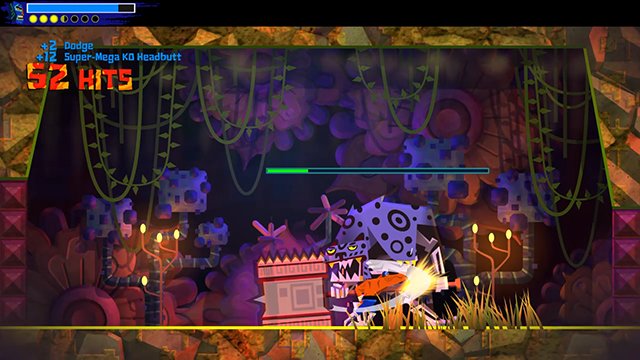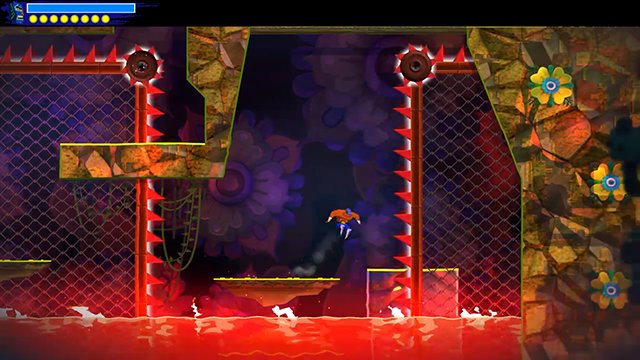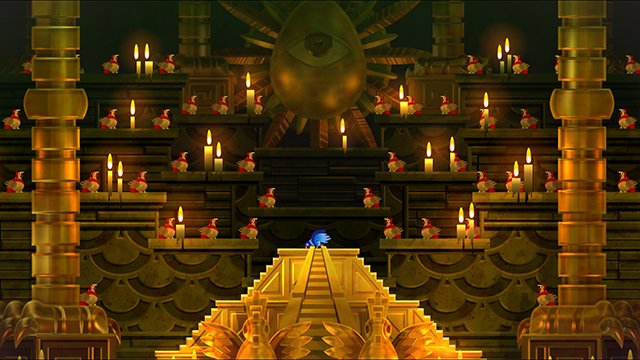Indie Metroidvanias were still somewhat of a novelty back in 2013. Even then, Guacamelee stood out among its peers because of its smooth platforming, wonderful music, hilarious writing, and gorgeous art style. I was a huge fan of that special game. And, judging by the glaring similarities and multitude of copied elements, so is GUACAMELEE 2. Guacamelee 2 successfully imitates the style of the first game but lacks the surprise and ingenuity necessary to top that original outing.
And what an original outing it was. It took the template of locking progression behind a power set that gradually unlocked over the course of the game and put its own spin on that formula. Guacamelee wasn’t about backtracking though; it was more focused on forward progression. This carried over into the suite of abilities, most of which were combat moves that doubled as traversal abilities. Its level design was only loosely inspired by Metroid and Castlevania as it swapped out the labyrinthine corridors for devious platforming challenges and tough melee brawls.
Guacamelee 2 Review: ¡Mucha Lucha!

Guacamelee 2 replicates that design wholesale. Dungeons are carved up into rooms that test your physical mettle and your skill traversing treacherous terrain. Combat is not just a means for breaking up the pace but strong enough to also serve as its own standalone gameplay pillar. It rides the line between simplicity and complexity, giving players enough moves to choose from while not requiring they memorize long combo lists or difficult animation cancels. Responsive controls ensure that your character does what you want them to do, when you want them to do it and invulnerable dashing will override any of your mistakes.
Cooperative Multiplayer
Guacamelee 2 has four-player co-op, and while I don’t have that many controllers, I was able to play a few sections with another person. It’s still the same game, but sometimes it gets harder to track who’s who during the more chaotic combat encounters. Thankfully, players can also “bubble” at any time, which helps those with less experience keep up.
Normally, fantastic fighting mechanics would be an unquestionable plus but the same glowing paragraph can be applied verbatim to the first game. Juan, or whatever character you pick, has the same moveset from the first game from the dash punch to the variety of throws. While there are some new, unique enemy types, they all fall to the same combos and throws that worked five years ago.
Mashing the exact punches just feels like too much like a copy of the original, even if it mostly stays fresh within the context of this specific game. New upgrade paths intended to add variety only end up only boosting your stats without adding combos or changing how you fight. Coming out with the same animations is hard to swallow no matter how good those animations are because it robs Guacamelee 2 of its own identity and opportunity to move out of the first game’s shadow.
Guacamelee 2 Review: An Homage of an Homage

As much can be said about the platforming but to a lesser degree. Gauntlets smoothly ramp up in difficulty, starting out as a light jumping puzzles then progressing into devilish death traps that require almost your whole array of powers as time goes on. Despite the odd decision to implement more frustrating one-hit kills, smooth controls and quick restarts always keep you moving forward. Hard difficulty spikes often stifle pacing but Guacamelee 2’s generous checkpoints avoid this problem and its associated tedium while also consistently maintaining a challenge. Although some dungeons are a bit too long and slow the pacing back down, forgetting the tight brevity of the first Guacamelee and thinking that more is better.
But, like the combat, platforming can also feel a bit too familiar. Since Juan has basically the same moveset and each serves a movement and combat function, the stagnation is a constant no matter if you’re uppercutting a skeleton or uppercutting over some spikes. The game gives you almost the exact same toolset, essentially hamstringing the amount of new types of levels it can throw in front of you. There are some exhilarating stretches of precision-based, reflex-intensive portions and each world usually adds in a gimmick or two, but they just feel like extended levels that didn’t quite make it into the first game. New challenges would need new abilities and since you only get one additional traversal ability, it severely limits how fresh the game’s platforming can be.
Guacamelee 2 Review: Pollo Power

Juan’s chicken form shows the amount of advancement the other parts of the game needed to have. This powerful pollo is no longer just a goofy way to pay homage to Samus Aran’s morph ball; it has its own unique set of skills and levels. And these levels are thrilling because of how they’re built around the chicken’s unique properties, thus granting the game a much-needed new set of challenges that the rest of the title lacks. It serves as a reminder how brilliant the game is when it steps out and expands on its foundation rather than using it as a crutch.
Chickens are also the best part of Guacamelee 2’s goofy story. Instead of running with the “save the princess” trope, it takes a more comic book-like multiverse angle. The Juan you play as is the one Juan that won against Calaca from the first game; essentially making that Juan “The One.” A man named Salvador rose in place of the defeated Juans and went down a dark path that compelled him to seek the all three pieces of a powerful, Mexiverse-ending artifact.
It’s undoubtedly a video gamey story that rises above its simple subject matter through its witty writing and silly moments. While the elongated level design occasionally throws off the humor’s pacing, the secret society of chickens, cheap but effective references, and self-deprecating comedy give the narrative its necessary charm even if it isn’t always laugh out loud funny. Despite the universe-ending implications, it’s all lighthearted and fits nicely with the vibrant visuals and infectious soundtrack that have also been pulled over from the first game, but have aged well.
Almost all of Guacamelee 2’s positive attributes can be applied to either entry in the franchise. Both have smooth controls, a lovely soundtrack, clever dialogue, and a striking visual style. But ingenuity is the key differentiating factor and that’s what drags down Guacamelee 2 from achieving the same level of greatness. It sacrifices originality for comfort. And that mask is still quite comfortable but, like dressing up as a luchador in back-to-back Halloweens, it’s not as impressive the second time around.
Guacamelee 2 was reviewed on PS4 via a digital code provided by the publisher.
-
Slick platforming and simple, fluid combat.
-
Hypnotic music and (mostly) snappy dialogue.
-
Chicken gameplay brings a welcome amount of variety.
-
Longer dungeon design drags out levels.
-
Nearly identical gameplay, music, characters, and power set from the first game.
-
Borrows too much of its predecessor’s identity.











